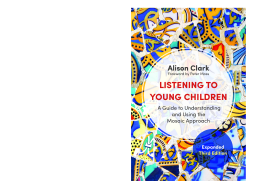
Additional Information
Book Details
Abstract
Viewing children as 'experts in their own lives', the Mosaic approach offers a creative framework for understanding young children's perspectives through talking, walking, making and reviewing material with an adult. This book demonstrates how children's views and experiences can stay in focus in early childhood provision. The multi-method approach brings together digital tools with interviewing and observation to enable adults to review current practice and implement change with children.
Combining the authors' successful books Listening to Young Children and Spaces to Play into an expanded and fully updated third edition, this book builds on the authors' original ground-breaking work by commenting on the development and adaptation of the Mosaic approach, along with case studies of the Mosaic approach in action in four countries: England, Denmark, Norway and Australia. Alongside guidance on using and adapting the framework with young children, older children and adults, there is new material on the ethical and methodological issues involved.
In this third, expanded edition of what has become a classic text about listening to young children, Alison Clark outlines the basis of the Mosaic Approach and its development. The addition of case studies and consideration of ethical issues creates spaces for reflecting, revisiting, and refining the application of the Mosaic Approach. A continuing strength of the book is the focus on the possibilities - rather than prescriptions - of listening to young children.
Sue Dockett, Professor of Early Childhood Education at Charles Sturt University
A refreshing, vibrant, ethical and highly collaborative approach to conducting research with children. I thoroughly recommend this much-needed resource.
Dr Rosie Flewitt, University College London, Institute of Education
I was delighted to see this third version appear, both because the topic is important and because Alison Clark and the Mosaic Approach impact fundamentally the way educational communities perceive children. The value of prioritising children's perspectives must not be underestimated. The planning of educators, shaping by policy-makers and investigations by researchers will all benefit from engaging with the examples and issues raised.
Alma Fleet, Honorary Associate Professor at Institute of Early Childhood, Macquarie University
Alison Clark's work on the Mosaic approach is enriched by new insights and material in this expanded third edition of 'Listening to Young Children'. This book is essential reading for students and practitioners engaged in the field of early years and early childhood.
Dr Rose Drury, Senior Lecturer in Early Years at The Open University
Alison Clark is a Visiting Research Associate at Thomas Coram Research Unit, UCL Institute of Education, London. Alison pioneered the Mosaic approach and has contributed many published articles, books and book chapters on listening to and researching with young children.
Table of Contents
| Section Title | Page | Action | Price |
|---|---|---|---|
| Listening to Young Children - A Guide to Understanding and Using the Mosaic Approach by Alison Clark | 3 | ||
| Foreword | 9 | ||
| Acknowledgements | 11 | ||
| Preface to the third edition | 13 | ||
| 1. A Framework for Listening | 17 | ||
| Introduction | 17 | ||
| Starting points | 20 | ||
| The framework for listening | 24 | ||
| 2. Listening to Young Children - Developing the Mosaic Approach | 31 | ||
| Introduction | 31 | ||
| The Listening to Young Children study (1999–2000) | 32 | ||
| Stages of the Mosaic approach | 33 | ||
| Stage One: Children and adults gathering documentation | 34 | ||
| Stage Two: Piecing together information for dialogue, reflection and interpretation | 56 | ||
| Discussion | 71 | ||
| 3. Spaces to Play - Adapting the Mosaic Approach | 75 | ||
| Introduction | 75 | ||
| Spaces to Play | 77 | ||
| Stage One: gathering children’s and adults’ perspectives | 80 | ||
| Stage Two: Discussing the material | 110 | ||
| Stage Three: Deciding areas of continuity and change | 113 | ||
| Evaluation | 119 | ||
| Changes into practice | 123 | ||
| Discussion | 125 | ||
| 4. Case Studies - Working with the Mosaic Approach | 131 | ||
| Introduction | 131 | ||
| Discussion | 151 | ||
| 5. Ethical and Methodological Questions | 153 | ||
| Introduction | 153 | ||
| Questions | 153 | ||
| Conclusion | 163 | ||
| Epilogue | 165 | ||
| Further reading about the Mosaic approach | 169 | ||
| Appendix | 171 | ||
| References | 177 | ||
| Subject Index | 185 | ||
| Author Index | 191 | ||
| Blank Page |
